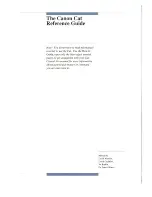Reviews:
No comments
Related manuals for Dimension 2200

Cat
Brand: Canon Pages: 160

PT-970 A Series
Brand: Contec Pages: 77

VCO-6020-1050TI
Brand: C&T Pages: 79

6-Bay mBTX PRO
Brand: Gateway Pages: 182

ZBOX nano ID61
Brand: Zotac Pages: 28

Vehicle-Mount Computer 8515
Brand: Psion Teklogix Pages: 190

ECS-9000
Brand: Vecow Pages: 127

ARK-3531 Series
Brand: Advantech Pages: 84

320-00-00010-01
Brand: Life Fitness Pages: 36

ATARI 400
Brand: Warner Communications Pages: 50

Max-80
Brand: Lobo Drives Pages: 40

IBDRW100-EX-P
Brand: Winmate Pages: 60

IH7T-RK2U
Brand: Winmate Pages: 92

SG3-300
Brand: HP Pages: 1

Slimline 270
Brand: HP Pages: 5

Slim 290
Brand: HP Pages: 5

s3330f - Pavilion - Slimline
Brand: HP Pages: 1

Slate 21
Brand: HP Pages: 40

















